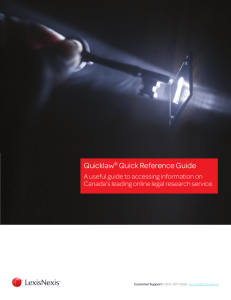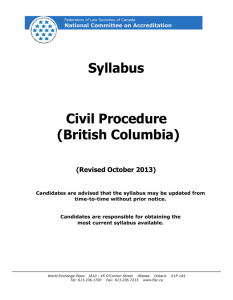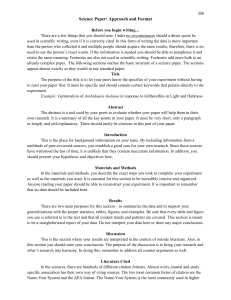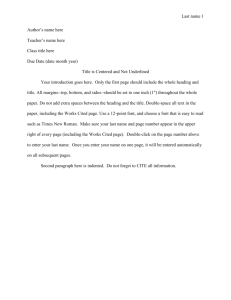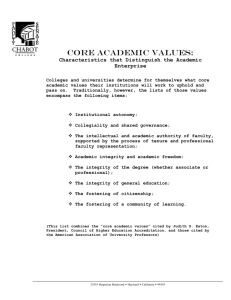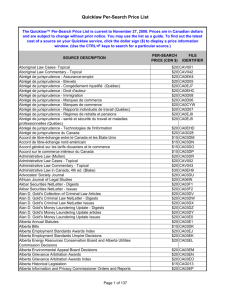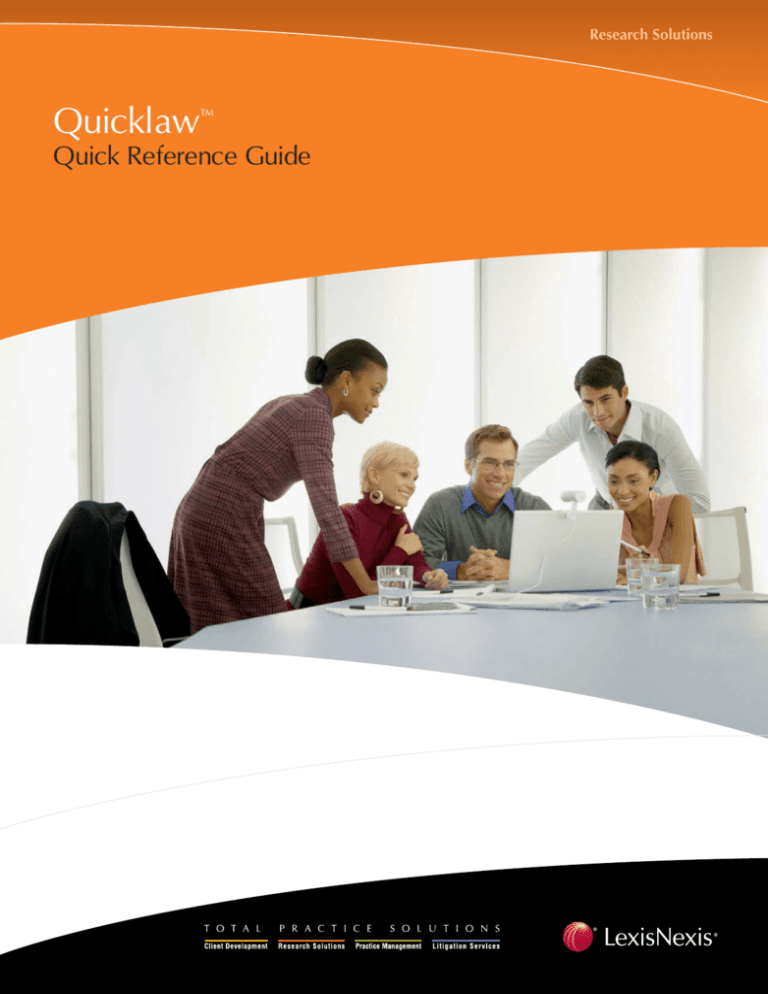
Research Solutions
Quicklaw™
Quick Reference Guide
Signing In
In your Internet browser, go to www.lexisnexis.ca, and choose Quicklaw™ from the
Product Sign On drop-down list at the top right. Enter your user ID and Password, and
then click the Sign In button. You will need to customize your password the first time you
sign in. You may then choose to save this information on your computer.
Client ID
The Client ID you use will appear on usage reports to track usage and pass on costs
to clients.
Choose or create a Client ID when you sign in, or by clicking the Client: link at the top of
any screen.
Find a Document
If you know the specific document you want, using the Find a Document section is the
fastest and most cost-effective method to locate cases, legislation, Canadian journal
articles, and definitions; to note up cases and legislation; to Shepardize® U.S. cases; or
to find a source.
1. Click the Search tab followed by the Home subtab.
2. Enter corresponding search terms or citations in the appropriate box.
3. Click the Go button next to the box with your terms, or press the Enter key on your
keyboard.
Basic Search
Located below Find a Document, the basic Search Sources form is useful for searching
across multiple content types or unfamiliar areas of law, or for general queries.
4. Enter your search terms in the box provided. By default, Quicklaw searches two or
more words as an exact phrase. You can also include connectors to link terms and
phrases, and to search for word variations.
5. Select a source from the drop-down list OR check one of the categories below such
as Cases, Legislation, or Commentary to limit your search to sources of a particular
type.
6. Click the Search button.
1
2
3
6
4
5
1
Customer Support: 1-800-387-0899 | service@lexisnexis.ca
Research Solutions
Connectors
By default, Quicklaw searches two or more words as an exact phrase. As a result, it is not
necessary to use quotation marks unless you want to bypass certain connectors (e.g.,
“search and seizure” will disengage the AND connector). Use connectors to establish
logical relationships between words and focus your search. If you use two or more of the
same connector, they operate left to right. If the n (number) connectors have different
numbers, the smallest number operates first. You cannot use the /p and /s connectors
with a proximity connector /n. Connectors operate in the following order of priority:
OR
lawyer OR counsel — finds documents in which either lawyer or counsel
or both appear. Useful for synonyms, antonyms, alternative spellings, or
abbreviations.
/n
drug /5 abuse — finds documents in which drug and abuse appear within
five words of each other (n=any number from 1 to 255)*. Useful for closely
related word searches.
+n
pay +3 television — finds documents in which pay precedes television by
three or fewer words. Useful where word order would markedly alter the
phrase’s meaning.
NOT /n
british NOT /2 columbia — finds documents in which the word british
occurs but the word columbia is not within two words of it. Use to avoid
specific phrases in results.
/s
sanction /s frivolous — finds documents in which the words sanction and
frivolous appear in the same sentence**. Useful for finding close but not
precise proximities.
/p
age /p discrimination — finds documents in which the words age and
discrimination appear in the same paragraph. Useful for less close
proximities of related words.
AND (&)
land AND trust — finds documents in which the words land and trust both
appear at some point in the document. Useful for broad searching, with
any word proximity.
AND NOT
trust AND NOT charitable — finds documents in which the word trust
occurs, but charitable does not. Highly exclusionary (e.g., will exclude
“not a charitable trust”).
NOT /para
cable NOT /para television — finds documents where both words cable and
television appear, but not within the same paragraph. Less exclusionary in
proximity.
NOT /sent
market NOT /sent share — finds documents in which the words market
and share appear, but not within the same sentence. Will exclude close
proximity terms only.
* The connector /n only searches within the same segment. If you want to search within
both the case name or summary and the body of the decision, use the AND connector.
** The connector /s searches within one sentence ending with a period. Quicklaw cannot
distinguish between a true period and the period following the v in case names such
as Hall v. Hebert. To search for case names, use the /n connector (e.g., Hall /3 Hebert).
Truncation and Wildcards
Truncation and wildcards are used to expand search terms.
!
acqui!
Finds variations on the term acquire (acquiring, acquisition, etc.)
*
Sp**gel
Finds both Speigel and Spiegel
2
Refine by Area of Law
From most search forms, you can add topics to search within a topical subset of
documents. This will let you restrict your results to a certain area of law, such as labour
or criminal law.
1
2
4
3
5
6
1. Click the Refine Search by Area(s) of Law link underneath the Enter Search Terms
box on the search form. The Subject Directory window opens sorted by Hierarchy.
Alternatively, you can search for areas using the Find option, or view all areas
alphabetically with the Alphabet option.
2. Click
to expand or
to contract listed terms to browse the contents hierarchy.
3. Click the
icon to find an explanation of what types of subjects will be searched, and
then click the Go Back button to return to the Subject Directory window.
4. Click the checkbox next to a term to select terms that match your research topic.
5. Click the View Selected button at any time to review a list of selected terms, then
click the connector link before each term (AND, OR, AND NOT) to cycle between
connectors, or click
to remove a term from the list.
6. Click OK – Add to Search in either the Hierarchy list or the Selected Index Terms list
to return to the search form. The terms you have selected are added to your search.
You may also toggle between AND, OR, and AND NOT at this stage by
clicking the connector link.
Content-Specific
Search Forms
Content-specific search forms are intended for searching sources of a specific content
type. These tailored search forms offer simplified searching within document segments
most commonly associated with their content. Quicklaw offers several content-specific
search forms, which are grouped in two ways:
1. Search subtabs appear across the top navigation and include Court Cases, Tribunal
Cases, Legislation, Commentary, Journals, Forms, and News & Companies.
2. Related content links appear on the left-side navigation and provide more detailed
search forms related to the Search subtab you have chosen.
Note: Not all forms are available with all subscriptions.
3
Customer Support: 1-800-387-0899 | service@lexisnexis.ca
Research Solutions
1
2
Date Searching
Several search forms allow you to limit your search by date or select a predefined time
frame. Select date parameters from the Specify Date drop-down list and enter your date
restrictions.
4
Search Results
The results page displays your search results and includes features that allow you to
select viewing options and sort, filter, or narrow your search.
1
3
5
6
2
4
1. View — view your results in different levels of detail (e.g., List, List with Keywords,
and Search Terms in Context).
2. Sort — change the order in which your results are displayed. (e.g., by Jurisdiction,
Court, Date, or Relevance).
3. Result Groups — filter displayed results (e.g., view results by Source, Source Type,
Topic, Court, or Jurisdiction).
4. View Multiple Groups — display a list of all groups that contain search result
documents, so that you may eliminate non-relevant groups such as courts, topics,
jurisdictions, or sources.
5. Narrow Search — search within existing results for a word, phrase, or new search
string.
6. Next Steps — modify your search, create a new search, save your search, or create
an alert.
Finding Sources
Use the Source Directory to locate any of the sources available in your Quicklaw
subscription. To access the Source Directory, click the Source Directory tab from any
page.
If you know the source you want to search, the quickest way to locate it is by using the
Find a Source search box located on the right-hand side of the Source Directory. This
function is also available in Find a Document under the Home subtab.
1
5
4
2
1. Click the Source Directory tab.
2. In the Find a Source quick-search box, enter keywords from the source name or the
former database code or source ID used in previous versions of Quicklaw (e.g., to find
the Ontario Judgments source, you can type Ontario Judgments or simply OJ).
3. Click the Go button, or
4. Browse Sources by selecting radio button options such as Publication Type, Area
of Law, News & Business, and Industry. You can then filter sources by Country (and
Region) and Topics.
5. To view all sources sorted alphabetically, or to perform a more detailed search, click
the Search for a Source subtab.
5
Customer Support: 1-800-387-0899 | service@lexisnexis.ca
3
Research Solutions
The Canada Digest
Access the Canada Digest form by clicking the Canada Digest link in the left-hand panel
under the Court Cases subtab. From here, you can search and browse extensive
collections of English- and French-language case summaries.
3
6
4
5
1
2
1. Click
to expand or to contract the LexisNexis® classification system to find
digests in a specific area of law. Drill down to the lowest hierarchy level to find the
classified digests, or
2. Click the checkbox next to a section(s) or subsection(s) you wish to browse.
3. Click the View Tagged button to browse only tagged items.
4. You can also search by entering terms in the Quick Search box. The Search on
Selected Items Only checkbox will automatically be checked if a checkbox has been
selected from the list.
5. Click the
icon at any time to view publication information about the digest.
6. Use the Canada Digest Search form to perform a more robust search.
QuickCITE™ Case Citator
A QuickCITE record can be retrieved via Find a Document or by clicking the Note Up
with QuickCITE link or citator symbol from the full text of a decision. QuickCITE Case
Citator records contain case information such as parallel citations, case history, lists of
subsequent citing cases, and the judicial treatments in those citing cases.
Case Treatment Symbols
1. Citator Information Icon
— the case has no known history or treatments. Click
this link to view more information about the citation.
2. Positive Treatment Icon
— the case has positive history (affirmed, judicial review
denied, or leave to appeal refused by a higher court) or positive treatments (followed
or followed in a minority opinion of a subsequent court).
3. Cautionary Treatment Icon
court.
— the case has been distinguished by a subsequent
4. Negative Treatment Icon
— the case has negative history (judicial review allowed,
reconsideration allowed, reversed, quashed, or varied by a higher court) or negative
treatments (not followed or questioned by a subsequent court).
5. Neutral Treatment Icon / History Treatment Icon
— the case has neutral
treatments (mentioned, explained, or cited in a dissenting opinion); or the case has
history (abandoned, abated, leave to appeal granted, reconsideration denied, related
proceeding, same case, or supplementary reasons by a subsequent court), but the
citing court doesn’t comment on the case.
6
Definitions of Case Treatments
1. Distinguished — cited case is held to be inapplicable due to a difference in fact or
law.
2. Explained — citing case adds to, expands upon, or interprets cited case. The cited
case is not decisive, but is given some kind of consideration.
3. Followed — citing case in a majority or plurality opinion applies a principle of law from
the cited case. The judge expressly relies on the cited case as a precedent on which
to base a decision.
4. Followed in Minority Opinion — citing case, in an opinion other than a majority,
plurality, or dissent, applies a principle of law from the cited case.
5. Cited in Dissenting Opinion — case is cited in a dissenting opinion.
6. Mentioned — citing case provides no more information about the cited case than what
is available in the cited case itself.
7. Not Followed — citing case overrules or refuses to apply the cited case for some
reason other than it was distinguishable.
8. Questioned — citing case criticizes the conclusion or reasoning of the cited case,
without refusing to follow it. Alternatively, legislation in force at the time the cited case
was decided has been amended to the extent that the cited case might have been
decided differently under the amended legislation.
QuickCITE™
Statute Citator
QuickCITE Statute Citator records contain a summary of judicial consideration,
treatments, pinpoint references, case names, citations, courts, dates, and signal
information. To access the search form, click the QuickCITE Statute Citator link to
the left of the Legislation search form.
6
1
2
3
4
5
1. Enter search terms, using connectors if entering multiple terms. Click View
Connectors … for more information on search string construction.
Remember: This form searches words contained in QuickCITE records only, not
in the full text of the legislation.
2. Select a Jurisdiction to limit results to federal and/or individual provincial legislation.
3. Enter the title of the act (e.g., Youth Criminal Justice Act).
4. Enter the citation of the legislation for which you are searching (e.g., R.S.C. 1985,
c. A-3). For more information on citation formats, click the Citation Help link.
5. Enter the section or article of the legislation (e.g., 244.1). Do not search for the
subsection (e.g., to find Criminal Code section 347(6), simply search for section 347
and then use a pinpoint reference to find subsection (6)).
6. Click the Search button.
7
Customer Support: 1-800-387-0899 | service@lexisnexis.ca
Research Solutions
Note: If you know the exact statute citation, you can also quickly note it up using Find
a Document under the Home subtab.
Definitions of Statute Treatments
1. Unconstitutional — cited statute section was determined by the court to be
unconstitutional.
2. Constitutionality Discussed — the constitutionality of the cited statute section is
discussed, but no final determination is made on the issue of constitutionality by the
court.
3. Pursuant to — action or proceeding was brought pursuant to the cited statute
section.
4. Considered — cited statute section was analyzed or interpreted by the court.
5. Referred to — cited statute section is referred to by the court with no further
discussion.
6. Cited — statute section has been cited and may contain a stronger judicial
treatment.
Canadian Legal Words
and Phrases
Under the Commentary subtab, you will see a link on the left-hand side to the
Canadian Legal Words and Phrases search form. Here, you can search from an
extensive dictionary of legal words and phrases, including selected Commonwealth,
Latin, and legislative term definitions.
4
1
2
3
1. Click the Browse link to browse the alphabetic list of Defined Terms, or
2. Enter terms in the Defined Terms box to limit your search to the definition field only.
For a more broad search, you can enter keywords in the Enter Search Terms box.
3. Select a Jurisdiction to limit results to federal and/or individual provincial courts.
4. Click the Search button.
Note: You can also find definitions using Find a Document under the Home subtab.
8
Viewing Entire Acts
To view an entire statute or regulation, you first have to view a section of that act:
2
1
3
1. Find and select any section of an act (e.g., Criminal Code, section 445).
2. From the View list, select Show Document Options.
3. From the View More list, click the name of the act (e.g., Criminal Code). The screen
will refresh and display the full act. This may take several minutes depending on the
size of the act.
History & Alerts
From the results page, you can click the Create Alert
icon and complete the form to
schedule your search to run automatically. Alerts can be set to email new documents to
you whenever the search runs. Quicklaw automatically saves your recent activity under
the History & Alerts tab.
1
2
3
1. History — displays your recent searches for up to 7 days and recently viewed
documents for up to 48 hours (up to a maximum of 100 searches/documents), and
allows you to redisplay these documents or revisit the search results.
2. Saved Searches — displays a list of your previously saved search strings.
3. Alerts — displays a list of your scheduled searches or legal updates. Legal updates
allow you to keep up to date with new case law within an area of law and jurisdiction.
9
Customer Support: 1-800-387-0899 | service@lexisnexis.ca
Research Solutions
Printing, Emailing, and
Saving Results
From a results list, you can select documents to view, print, email, or download, or
copy the list:
3
2
1
4
1. Select the checkbox at the top of the results list to tag all the documents, or select
the checkbox next to a document title to tag an individual document.
2. Click the Add to
link to add selections to the Delivery Folder, and view or deliver
them up to 24 hours later.
3. View and re-order any documents in the Delivery Folder by clicking on the View
link.
4. Click the Print, Email, Download, or Copy Results Link icon to select a delivery
method. A new window will open, allowing you to modify relevant options and deliver
or save your results.
Signing Out and
Help Files
Click the Sign Out link in the Navigation Bar at the top right of any screen to log off
your session. Here, you will also find the Help link to access all available online help
files.
Quicklaw
Customer Support
Quicklaw comes with free training and support — available in one of our offices
across Canada, person-to-person in your office, or via web-based sessions. Call
1-800-387-0899 or email service@lexisnexis.ca for assistance or more information, or
email training@lexisnexis.ca to register for training. When you call, please try to be
near your computer and have your ID ready. Click the My ID link at the bottom of the
page (if available) when connected to see your ID.
10
Research Solutions
Quicklaw™
Quick Reference Guide
Quicklaw Customer Support and Training
Call 1-800-387-0899 | Email service@lexisnexis.ca I training@lexisnexis.ca
www.lexisnexis.ca
LexisNexis, the Knowledge Burst logo, and Shepardize are registered trademarks of Reed Elsevier Properties Inc.,
used under licence. Quicklaw and QuickCITE are trademarks of LexisNexis Canada Inc. © 2009 LexisNexis Canada Inc.
All rights reserved. QL-QRG-06/09

